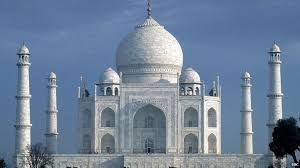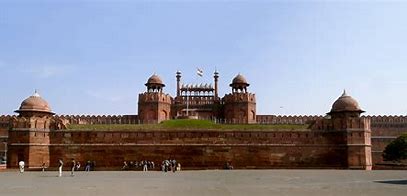.jpg)

.jpg)

The Taj Mahal incorporates and expands on design traditions of Indo-Islamic and earlier Mughal architecture. While earlier Mughal buildings were of red sandstone, Shah Jahan promoted white marble inlaid with semi-precious stones. Buildings under his patronage reached new levels of refinement. The tomb is the central focus of the entire complex of the Taj Mahal. It is a large, white marble structure standing on a square plinth and consists of a symmetrical building with an iwan (an arch-shaped doorway) topped by a large dome and finial. Like most Mughal tombs, the basic elements are Indo-Islamic in origin. The base structure is a large multi-chambered cube with chamfered corners forming an unequal eight-sided structure approximately 55 meters (180 ft) on each of the four long sides. Each side of the iwan is framed with a huge pishtaq or vaulted archway with two similarly shaped arched balconies stacked on either side. This motif of stacked pishtaqs is replicated on the chamfered corner areas, making the design completely symmetrical on all sides of the building. Four minarets frame the tomb, one at each corner of the plinth facing the chamfered corners. The main chamber houses Mumtaz Mahal and Shah Jahan; the actual graves are at a lower level. The most spectacular feature is the marble dome that surmounts the tomb. The dome is nearly 35 meters (115 ft) high which is close in measurement to the length of the base and accentuated by the cylindrical "drum" it sits on, which is approximately 7 meters (23 ft) high. Because of its shape, the dome is often called an onion dome or amrud (guava dome). The top is decorated with a lotus design which also serves to accentuate its height. The shape of the dome is emphasized by four smaller domed chattris (kiosks) placed at its corners, which replicate the onion shape of the main dome. The dome is slightly asymmetrical. Their columned bases open through the roof of the tomb and provide light to the interior. Tall decorative spires (guldastas) extend from the edges of base walls and provide visual emphasis to the height of the dome. The lotus motif is repeated on both the chattris and guldastas. The dome and chattris are topped by a gilded finial that mixes traditional Persian and Hindustani decorative elements. The main finial was originally made of gold but was replaced by a copy made of gilded bronze in the early 19th century. This feature provides a clear example of the integration of traditional Persian and Hindu decorative elements. The finial is topped by a moon, a typical Islamic motif whose horns point heavenward. The minarets, each more than 40 meters (130 ft) tall, display the designer's penchant for symmetry. They were designed as working minarets— a traditional element of mosques used by the muezzin to call the Islamic faithful to prayer. Each minaret is effectively divided into three equal parts by two working balconies that ring the tower. At the top of the tower is a final balcony surmounted by a chattri that mirrors the design of those on the tomb. The chattris all share the same decorative elements of a lotus design topped by a gilded finial. The minarets were constructed slightly outside of the plinth in the event of collapse, a typical occurrence with many tall constructions of the period, the material from the towers would tend to fall away from the tomb. The exterior decorations of the Taj Mahal are among the finest in Mughal architecture. As the surface area changes, the decorations are refined proportionally. The decorative elements were created by applying paint, stucco, stone inlays, or carvings. In line with the Islamic prohibition against the use of anthropomorphic forms, the decorative elements can be grouped into either calligraphy, abstract forms, or vegetative motifs. Throughout the complex are passages from the Qur'an that comprise some of the decorative elements. Recent scholarship suggests that Amanat Khan chose the passages. The calligraphy on the Great Gate reads, "O Soul, thou art at rest. Return to the Lord at peace with Him, and He at peace with you." The calligraphy was created in 1609 by a calligrapher named Abdul Haq. Shah Jahan conferred "Amanat Khan" upon him as a reward for his "dazzling virtuosity." Near the lines from the Qur'an at the base of the interior dome is the inscription, "Written by the insignificant being, Amanat Khan Shirazi." Much of the calligraphy is composed of florid thuluth script made of jasper or black marble inlaid in white marble panels. Higher panels are written in a slightly larger script to reduce the skewing effect when viewed from below. The calligraphy found on the marble cenotaphs in the tomb is particularly detailed and delicate. Abstract forms are used throughout, especially in the plinth, minarets, gateway, mosque, jawab, and, to a lesser extent, on the surfaces of the tomb. The domes and vaults of the sandstone buildings are worked with tracery of incised painting to create elaborate geometric forms. Herringbone inlays define the space between many of the adjoining elements. White inlays are used in sandstone buildings and dark or black inlays on the white marbles. Mortared areas of the marble buildings have been stained or painted in a contrasting color, creating a complex array of geometric patterns. Floors and walkways use contrasting tiles or blocks in tessellation patterns. On the lower walls of the tomb are white marble dados sculpted with realistic bas relief depictions of flowers and vines. The marble has been polished to emphasize the exquisite detailing of the carvings. The dado frames and archway spandrels have been decorated with pietra dura inlays of highly stylized, almost geometric vines, flowers, and fruits. The inlay stones are of yellow marble, jasper, and jade polished and leveled to the surface of the walls.